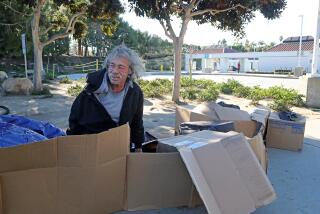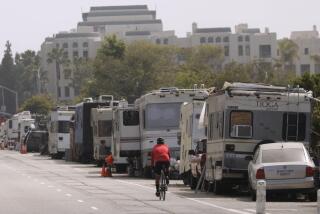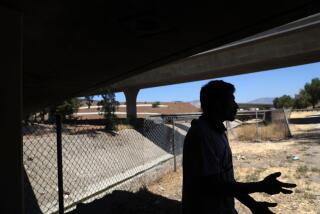Council Moves to Rid Area of Homeless Encampments : Ordinance: Officials want to pattern new law after Santa Barbara’s ban on sleeping on public property. Critics wonder where up to 5,000 homeless people can be relocated.
- Share via
LONG BEACH — The City Council, though taking care to stress its concern for the homeless, moved this week to make it illegal for homeless people to sleep or camp overnight in public places.
Handling the topic gingerly, the council voted unanimously Tuesday to ask the city attorney’s office to prepare a local ordinance patterned after Santa Barbara’s ban on sleeping on public property.
“I think it’s a very difficult issue,” Councilman Wallace Edgerton, who introduced the motion, said in an interview. “The community out there wants some action. Hopefully, we can take some action and realize we’re dealing with people and not debris.”
Edgerton--who has made many speeches condemning panhandlers and told the homeless to get jobs--was unusually brief in his comments on the matter Tuesday. He said the ordinance was city management’s idea, and he insisted that it would help homeless people.
“The purpose is to have them removed and placed somewhere where they can get help if they want help,” Edgerton said, calling the proposed ordinance a “win, win, win situation.”
Long Beach joins several Southern California communities weary of having abandoned lots and parks used as bedrooms.
In addition to Santa Barbara, West Hollywood banned overnight sleeping in its parks when it opened a shelter two years ago. Even Santa Monica, known for its tolerance of the homeless, is considering a law to keep homeless people from living in city parks.
But in Long Beach, the question remains where the estimated 3,000 to 5,000 homeless will go if they are shooed off the streets and out of the parks every night.
“I think there is a responsibility that flows to the city and no one else,” said Councilman Warren Harwood. “I want to make sure we take on some responsibility for the results of dispersing (the homeless.)”
The city relies on a patchwork of private agencies to take in the homeless, along with the county’s cold-weather program, which provides shelter on cold and rainy nights.
City lists show some 800 beds available for the Long Beach homeless. But homeless advocates say the figure is misleading. Many of those beds are open only to people in specific programs, such as those for recovering alcoholics. And 300 beds are in the Salvation Army’s Bell shelter, which takes people from a number of communities and is often full.
Edgerton insisted that there is adequate shelter for the homeless available, if not in Long Beach, then elsewhere.
“The assumption is there is a place for them to go,” Edgerton said later. “It is my understanding the facilities are available.”
John Jensen, president of Christian Outreach Appeal, which feeds the homeless, disagreed. “Ask him where,” countered Jensen. “We don’t have beds. We need them.”
Bonnie Lowenthal, a longtime member of the city’s Homeless Services Advisory Committee, asked: “How can the number of emergency shelter beds--which we felt were inadequate in 1987 . . . be adequate for a homeless population that has probably doubled at the very least, given the current economic climate?”
City Manager James C. Hankla, remarking that an overnight sleeping ban would “give us more options,” said the city would try to act as a clearinghouse to hook the homeless up with the appropriate social services.
He emphasized that when city workers recently conducted sweeps of homeless camps near downtown, social workers went along to offer help. The city even videotaped the exchanges.
Mayor Ernie Kell supported the proposed ordinance, praising Edgerton for tackling the issue. “I think people are getting real tired of being panhandled,” Kell said. “It’s degrading to the community. . . . Even though someone is homeless, they still have to adhere to the basic principles that we in a civilized society expect.”
Councilman Tom Clark was absent and did not vote on the proposed ordinance.
Officials say residents and business owners have complained to them in the past about the homeless.
More to Read
Sign up for Essential California
The most important California stories and recommendations in your inbox every morning.
You may occasionally receive promotional content from the Los Angeles Times.











